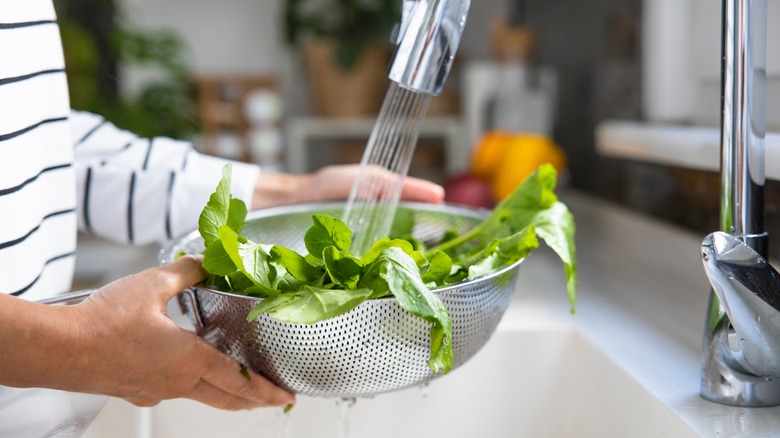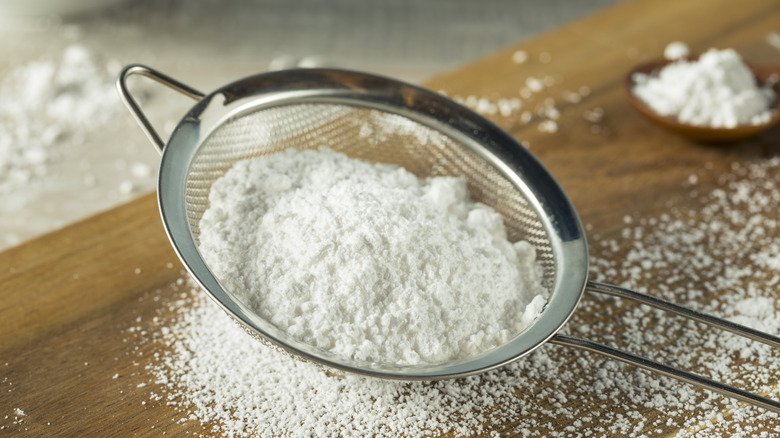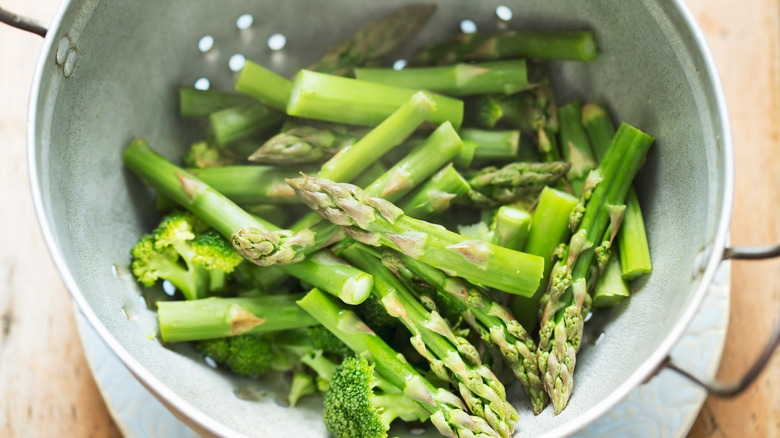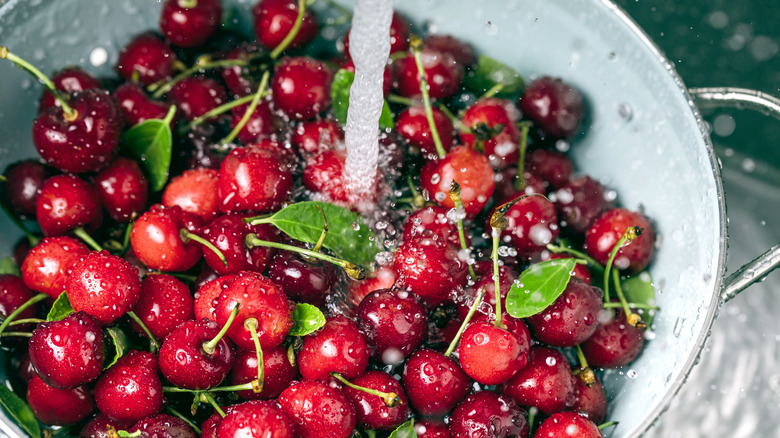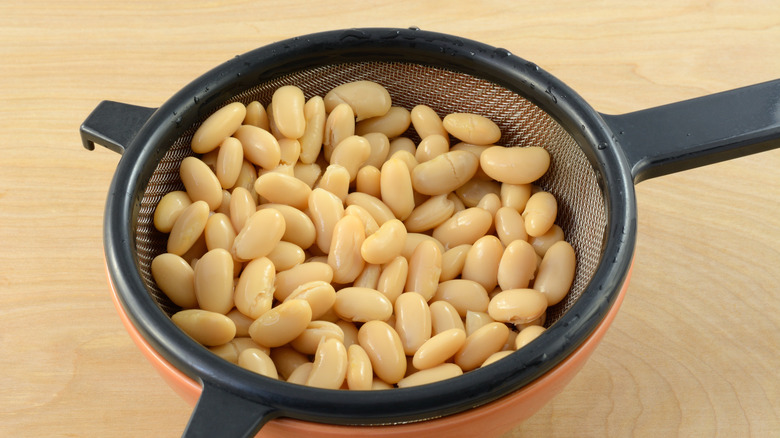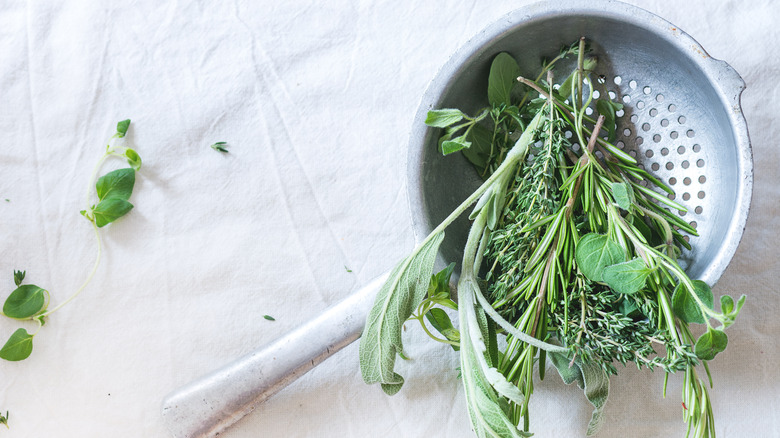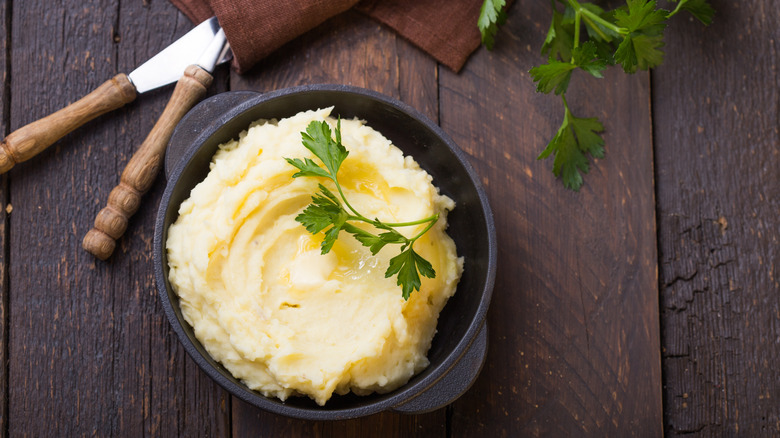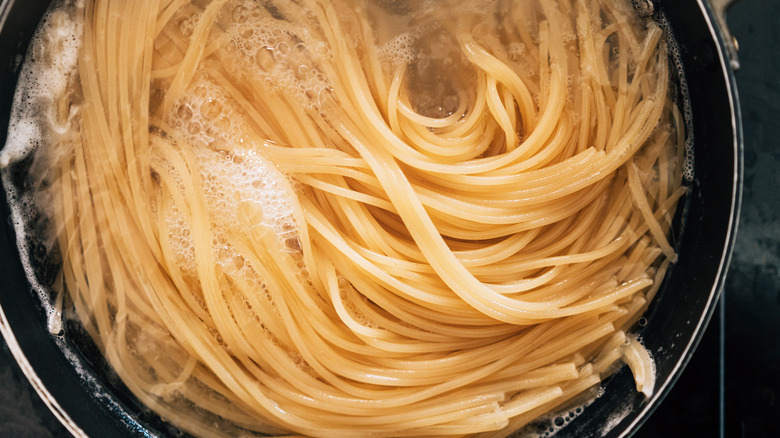The Absolute Best Uses For Your Colander
The colander you bust out only when you need to drain some boiled pasta or potatoes is a super handy and essential tool for your kitchen. It has the potential to be way more than the second stop for a pot of hot carbs.
To be clear, colanders come in a lot of different shapes and sizes. Some have fewer but wider drainage holes, while others have smaller but more plentiful drainage openings. In other words, all fine mesh strainers are considered colanders, but not all colanders are fine mesh strainers. Some colanders are built to rest on the sides of your sink, while others are small and equipped with one handle designed to be held over a wider bowl. The types of colanders you want to keep around your kitchen depend on what you cook the most often — but that doesn't mean you shouldn't maximize the potential of what you do have. We'd venture to guess you are not taking advantage of your colanders' full range of services. Keep reading for a breakdown of the best uses for your colander, including some you might have never considered. You're welcome in advance.
Sifting dry baking ingredients
Oftentimes a baking recipe will call for "sifted flour" or "powdered sugar, sifted." If the term sifted is written before the ingredient, it means to sift your substance and then measure it. However, if the term sifted is listed after the item, you measure out the ingredient prior to sifting.
Powdered sugar often needs sifting if you want to ensure it doesn't taste gritty or clumpy. When it comes to flour, sifting lightens the flour in case it has clumped up from being packed together. It guarantees it's free of clumps and ready to easily blend with the other dry ingredients. There is, of course, a kitchen tool called a sifter, but if you don't have one of those, you can use a fine mesh colander to get the job done. It also works for powdered sugar.
Just make sure that you have a mixing bowl that's bigger than the colander so you can place the colander over the bowl, pour the flour or sugar into the colander, then gently tap it against the sides of the bowl, letting the ingredient sift through the holes of the colander. Again, just make sure to confirm whether the dry ingredient is supposed to be measured before or after it's sifted.
Steaming vegetables
Steaming is a fool-proof method for getting some healthy vegetables ready to eat and on your plate. But what if you don't have a steamer basket? Enter the colander. If you have a metal colander that can fit into one of your pots, you've got a vessel for steaming vegetables. If it doesn't nestle into the pot, make sure it's got a handle, and you've got an oven mitt to keep your hands safe, and you can hold it over the boiling water as it steams your dinner.
Per the experts at Food 52, simply fill a pot with water (only with about half an inch of water since the top of the water shouldn't touch the bottom of the colander), place the veggies into the colander, then start to boil the water. Once it's boiling, reduce the heat and cover the pot as sufficiently as possible considering the colander-in-pot circumstances. A few minutes later (cooking times vary depending on the food), and voila, you've got vegetables steamed via a colander.
Washing produce
In general, you aren't going to find many people who enjoy the task of washing fruits and vegetables. Unfortunately, it's one of those annoying first steps we all have to take if we don't want to accidentally ingest dirt, mold, or even pesticides. So once again this is a key time to utilize that colander you thought could only drain spaghetti.
Honestly, once you start washing produce in a colander, the idea of rinsing it by the handful under running water is going to seem archaic. The colander is a game-changer for rinsing those berries or cleaning that big bunch of romaine lettuce. In fact, according to the kitchen masters at Fine Dining Lovers, colanders are the ideal vessel for washing produce in the sink under the tap. From strawberries to blueberries to lettuce, you could quickly assemble an entire summer salad simply by rinsing your produce in a colander.
Draining canned food
Canned beans are perhaps one of the greatest inventions of our time because, let's face it, soaking dry ones for hours feels overwhelming when you just need your beans. The canned ones, however, do come with a heavy dose of starchy, salty liquid that keeps them preserved on that shelf. Most recipes that allow canned beans suggest rinsing them before tossing them in, which cleans off some of that excess starch and sodium, hopefully improving the beans' flavor and texture.
Simply place your colander in the sink, dump in the can of beans, and rinse the beans under running water while gently shaking the colander. Once the bubbles start to clear, you're usually good to go with the beans. Drain as much of the liquid as you can before proceeding to the next step in the recipe. Other canned items can easily be drained in a colander, too, but the rinsing step might depend on how you're using the food.
Stripping herbs
It turns out that colanders are miracle workers when prepping fresh herbs for a recipe, too. If pulling the leaves off a sprig of thyme before chopping them is the bane of your existence, this colander hack is definitely for you.
The next time a recipe calls for finely chopped thyme leaves, simply string the thyme sprig through the hole of a colander, then pull it through. This technique effectively pulls all of the tiny thyme leaves off the sprig, so then all you have to do is chop them. Just make sure that you pull the sprig through the hole from underneath the colander, that way all of the leaves end up neatly piled in the bowl (via Taste of Home). This suggestion is truly life-changing, we know. This technique does tend to work best with a fine-mesh strainer, or at least a colander with drainage holes that are only slightly larger than the thyme sprigs.
Making mashed potatoes
You have likely used your colander many times to drain boiled potatoes before mashing them. But you probably didn't realize you can make mashed potatoes with potatoes that have been "riced," not just mashed. The technique you use to break down the potatoes has more impact on the final texture of the mashed potatoes than any added ingredients such as butter or heavy cream (via Elpasony). Riced potatoes can be achieved using a ricer or food mill, but, if you don't have either on hand, you can sub in your colander.
This method works best with peeled potatoes, but you will need to muster some arm strength and press the boiled potatoes through the holes of the colander, forming rice-like pearls, using the bottom of a small bowl or the back of a spoon. It's worth a try to see if you get a mashed potato side dish that's fluffier and lighter than what you might normally taste by simply using a potato masher on some boiled, unpeeled potatoes.
Drying cake pops
Making a batch of cake pops at home? First of all, let us commend you, that takes creativity and ambition. Your friends and family are lucky to have you in their life. But also let us remind you that this is yet another chance to use your trusty colander.
Since most cake pops are dipped in some sort of chocolate coating, they then need a place to dry while remaining upright to maintain the integrity of the beautiful pops. As suggested by the lifestyle blog Priya Creates, the holes of a colander are ideal for holding the finished cake pops while their outer layer firms up. Just make sure you test the sticks in the holes to make sure they stay securely in place. We don't want you standing in the kitchen with a batch full of freshly dipped cake pops and nowhere to safely store them while their chocolate shells harden to perfection.
Reheating pasta
If your go-to process for reheating pasta is nuking it in the microwave, you are doing yourself a serious disservice. There are many ways to reheat pasta so that it can taste just as good as the night you cooked it (or ordered it from your favorite Italian restaurant).
When it comes to plain pasta in particular, because some people like to combine just enough sauce and pasta for their serving, then store any leftovers separately, your metal colander can come to the rescue. According to the pasta enthusiasts at Real Simple, to reinvigorate plain noodles that have previously been cooked but have been resting in the fridge here's what to do: Bring a pot of water to a boil, place the leftover pasta in a metal strainer, then submerge the colander of pasta into the boiling water for approximately 30 seconds. This technique saves you from the horrors of mushy, dry pasta noodles. Then, of course, you should add some of your favorite sauce.
